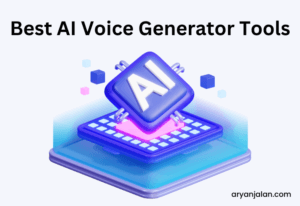Nowadays, chatbots are among the most popular and essential tools for online businesses, but chatbots’ discovery is not a recent one. Chatbots have been around for quite a while now.
Mostly because of the messaging platforms’ immense popularity over the past few years, chatbot trends are rising.
Let us explore the various aspects of chatbots and see how we can use chatbots effectively to make human lives simpler.
What Is Chatbot?
Chatbots are AI-based computer applications that simulate human conversation through voice or text command.
Chatbots were designed with the sole aim of reducing human efforts. And because of continuous evolution in technology, interaction with the chatbot is much more comfortable than interacting with humans for common and generalized questions.
Chatbots can be easily customizable, and they can be programmed as per your requirement. Or you can use chatbot builders and build your chatbot without any coding skills.
If you’re running a retail business or a business that needs to answer similar questions repeatedly, like order status, shipment process, etc., then humans are much costly. But with the help of chatbot, you can increase your response rate with upto 200% and save lots of money and reply to your customers answer very quickly.
For example, Airline companies use powerful chatbots so that the passengers can easily track all the details of their journey. Using the chatbots, the passenger can track all the details very quickly like flight updates, boarding pass, ticket purchase information, etc. That will keep the passengers happy, but the entire process will also become speedy and exact without any human intervention.
How does chatbot work?
Chatbots are just like a human being working at a helpdesk. Once the chatbot receives any customer input, it checks in their database about the relevant answer and will respond to the customer within seconds.
A chatbot generally gives two types of responses. The response can be a piece of information stored in its database. Or it can depend on your question, see the example below.
In the image, Poncho is the name of the chatbot.

What are the different types of chatbots?
Quick Reply/ Scripted Chatbots – It is one of the simplest chatbots. It works with predefined conditions. This type of chatbots are mainly used to increase website engagement and be used as customer support with predefined questions and answers.

AI & NLP Powered Chatbot – It’s one of the most prominent applications. Allows you to chat with the robot like a human. This type of chatbot uses Machine Learning (ML), Artificial Intelligence (AI) and Natural Language Processing to understand user instruction. These types of chatbot conduct a smart conversation with speed and efficiency.
Context Enabled Chatbot – This also comes in the category of the advanced chatbot. Their primary aim is to figure out the user intent, i.e. in which sense or proportion the user asks a question or doing some random stuff on the website. It then reverts those sentiments and behaviour according to the intentions of the user.
These chatbots remember the last things a user has already asked or performed and based on that, and it presents a more thoughtful answer as we can see in the image below.


Voice-based Chatbot – Voice-based chatbot also comes in the category of the advanced chatbot. These types of chatbots are trained to understand the command orally or in the written form. It can be further divided into two parts, and the first one only responds to you via voice while the other can respond via voice and text together.
Most popular examples of voice-enabled chatbots are Amazon Alexa, Google Home.
How to build your own chatbot?
Given below are some of the most crucial steps using which you will be able to develop a chatbot for your business or company:
Step 1: Understand your customers’ expectations: Before designing your chatbot, you need to understand your customer behaviour. Knowing your customer behaviour and needs will help you to create a chatbot with the required features.
That will increase your engagement rate with your customers and show massive growth in your business’s revenue.
Step 2: Choose the right platform: Chatbots are highly flexible applications. Chatbots are easy to integrate a chatbot with any platform of your choice. However, you need to know which platform is most suitable for your target audience. You can use a chatbot for a mobile application or with a website. It can also integrate with social messaging platforms like Facebook Messenger, Instagram, Twitter, Skype, etc.
Step 3: Develop your chatbot: There are two most common ways to develop a chatbot for your business. You can use DIY chatbot builders or opt for a framework (Microsoft Bot Framework, Wit.ai, Botpress) to develop a chatbot (If you’ve from coding background).
Using chatbot development tools, you can create a chatbot with limited functions only. And with the help of a framework, you can create a more customized chatbot for your business.
Step 4: Testing and deployment: The final step is to see whether your chatbot performs well or not as per your business requirements. It is good to test your chatbot with all posible queries before adding it to your website or social media platform to fix the unwanted bugs.
And you can also ask a few of your customers to test your chatbot to know if that works for them or not if they’re happy and satisfied with the answers given by chatbot. That means your chatbot is ready to add value in your business.
In case you don’t have technical and coding knowledge and don’t have time to do. Then you can also hire a chatbot developer from freelancing websites like Freelancer.com, Upwork.com. Fiverr.com.
Conclusion
At last, we can say that automation is the future. Chatbots are still in their initial stage. More advanced chatbots are yet to come in the market to completely revolutionised the digital market.



